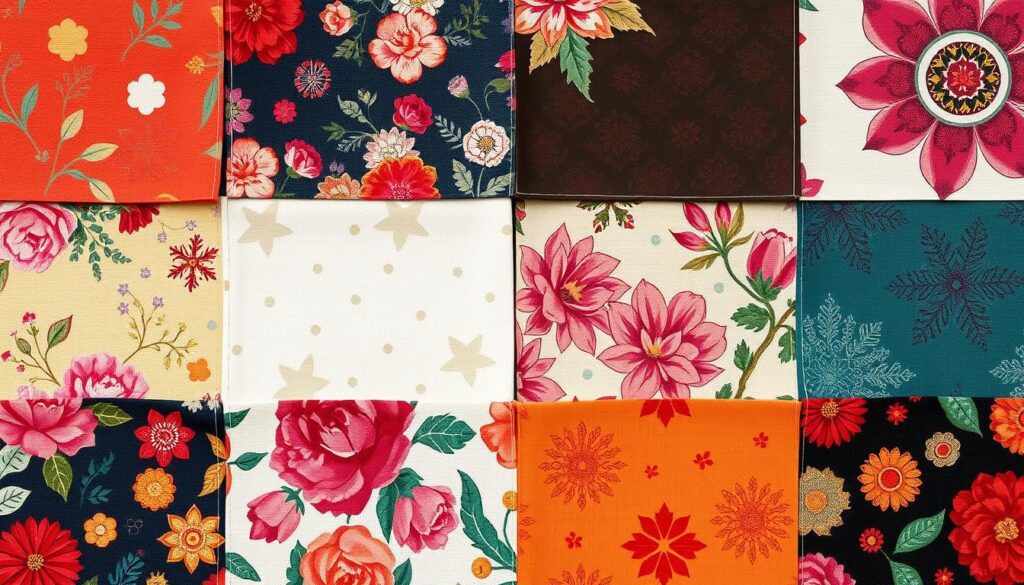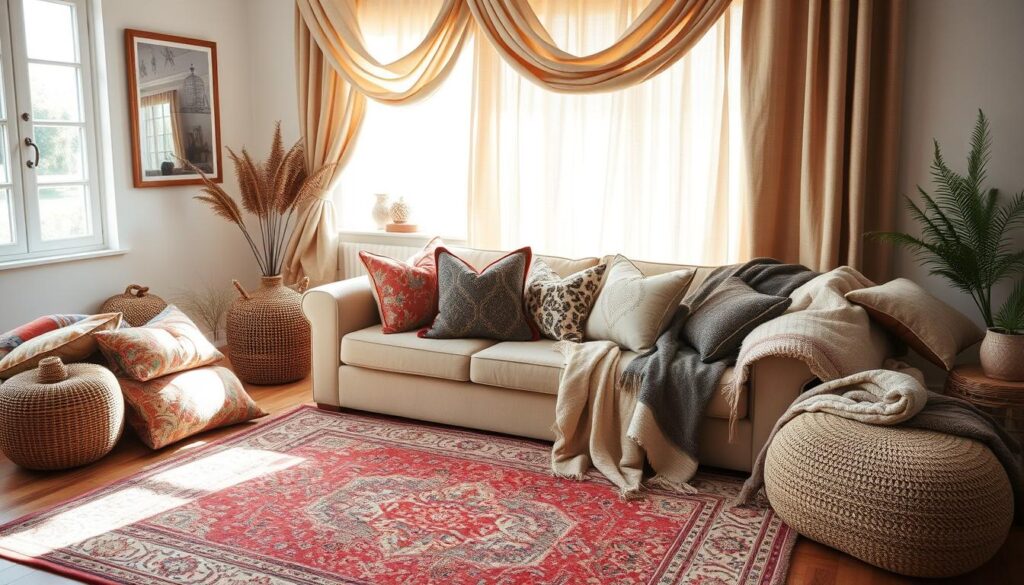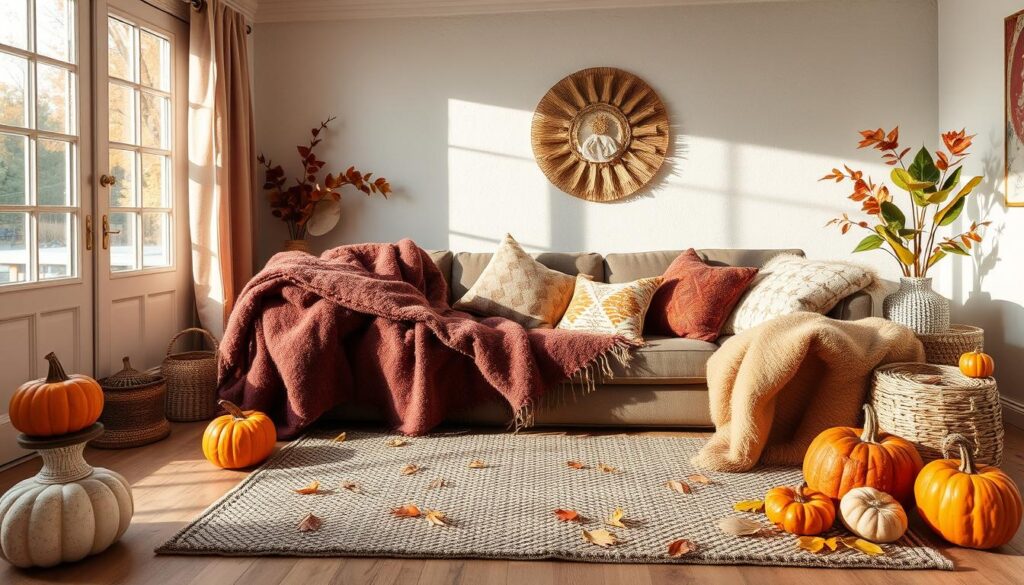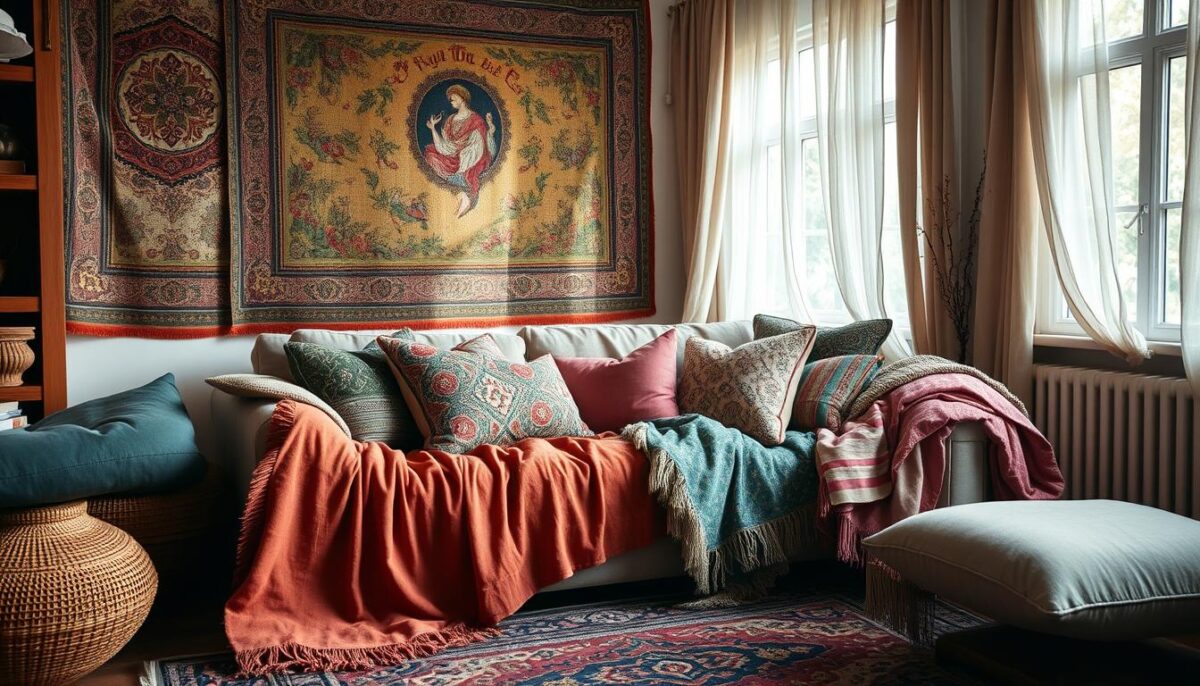Ready to make your living spaces cozy and inviting? Layered textiles are the key. In this guide, we’ll show you how to use fabrics, patterns, and textures to transform your home. Get ready to be inspired as we dive into the art of layering and how to enrich your decor.
Key Takeaways
- Learn how layering textiles can add depth and visual interest to your home decor
- Discover the impact of texture and how to incorporate it into your design aesthetic
- Explore the art of combining fabric patterns and colors for a cohesive, harmonious look
- Understand the role of window treatments and other decorative elements in creating a layered look
- Gain insights on balancing different textures and patterns for a visually stunning result
The Power of Layering Textiles
Layering textiles can transform any room. It adds depth, dimension, and visual interest. By mixing different fabrics, patterns, and textures, you can make a cozy and sophisticated space. Learn why layering is key and how it changes your home’s look.
Why Layering Matters
Layering textiles is more than decoration. It’s a way to create a harmonious and visually appealing space. It brings depth and complexity to a room. This method lets you play with texture, fabric combinations, and visual depth, making your space inviting and beautiful.
The Visual Impact of Texture
Texture is vital in layering textiles. It adds interest and a touchable quality to your decor. Mixing smooth and rough, matte and shiny, or plush and crisp fabrics creates a dynamic space. This layering of textures also adds to the visual depth of a room, making it feel more dimensional.
| Fabric Type | Texture | Visual Impact |
|---|---|---|
| Velvet | Plush, Smooth | Luxurious, Cozy |
| Linen | Crisp, Lightweight | Airy, Casual |
| Wool | Soft, Cozy | Warm, Inviting |
| Silk | Smooth, Lustrous | Elegant, Sophisticated |
Understanding the power of layering textiles and texture can transform your home decor. It creates spaces that are stunning and welcoming.
Mastering the Art of Textile Layering
Layering textiles in your home decor is an art that needs a good eye for color, pattern, and texture. We’ll dive into the key principles and techniques to layer fabrics well. This will change your living spaces.
To master textile layering, you must understand how different materials work together. Choosing fabrics that complement each other and arranging them thoughtfully can add depth and coziness.
Identifying the Right Fabrics
Start by gathering a variety of fabrics with different textures and weights. Mix in:
- Soft, plush fabrics like velvet or chenille
- Crisp, structured materials such as linen or cotton
- Cozy, knitted pieces like throw blankets or chunky pillows
- Sheer, lightweight elements like sheer curtains or voile panels
This mix of textures will make your space visually appealing and engaging.
Layering Techniques and Placement
The way you place and arrange your fabrics is key. Try out different methods, such as:
- Draping throw blankets over the back of a sofa or armchair
- Arranging decorative pillows in a coordinated pattern
- Hanging sheer curtains over solid window treatments
- Layering area rugs or overlapping smaller rugs for a cozy effect
By carefully placing your textiles, you can create a welcoming and harmonious space.

“Layering textiles is like composing a symphony. Each fabric is an instrument, and when played in harmony, they create a symphony of comfort and style.”
Remember, mastering textile layering is a journey. Experiment, play, and trust your instincts. Find the perfect mix of how to layer textiles, textile layering techniques, and interior design tips to enhance your home decor.
How to Add Depth to Your Decor with Layered Textiles
Decorative pillows and throw blankets are key for adding depth to your home. They make your space cozy and inviting. Plus, they boost the visual appeal of your living areas.
Incorporating Decorative Pillows
Decorative pillows bring different textures and patterns into your decor. Mix fabrics like velvet, linen, or textured throws. Try various sizes and arrangements for a stunning look.
Playing with Throw Blankets
Throw blankets add warmth and depth to your decor. Use them over a sofa, at the bed’s foot, or on a chair. Combine fabrics like chunky knits, soft fleece, or patterned throws for a dynamic look.
| Decorative Pillows | Throw Blankets |
|---|---|
|
|

Decorative pillows and throw blankets make your home more interesting. Try out different fabrics and patterns. This way, you can create a cozy space that shows off your style.
Exploring Fabric Patterns and Colors
Learning how fabric patterns and colors work together is key to great textile layering. You can find everything from bold geometric prints to soft floral designs. The goal is to mix colors and patterns in a way that looks good and feels right.
Complementary Palettes
Color theory is important for layering fabrics. Complementary colors, those opposite each other on the color wheel, make each other pop. By mixing bright colors and patterns, you can make your design stand out and add depth.
Start by trying out different fabrics together. Mix big prints with small ones, or warm colors with cool ones. There are so many ways to do it, and the results can be amazing.

Don’t be afraid to try new things with fabric patterns and colors. It’s all about having fun and letting your creativity show. As you layer your fabrics, you’ll create a space that’s both beautiful and balanced.
Window Treatments and Textile Layering
Window treatments are key to adding depth and texture to your home. Draperies, curtains, and other window coverings blend well with your textile layering. This creates a stunning and cohesive design.
Adding window treatments to throw pillows, blankets, and rugs can make a room look better. By matching colors, patterns, and textures, you get a harmonious look. This adds depth to your decor in a striking way.
Start with sheer or patterned curtains as the base. Then, add heavier drapery panels or valances for a fancy look. Mix these with throw pillows, blankets, and textured rugs for a cozy and inviting space.

Try different layering methods for a unique look. Mix fabrics like velvet, linen, or silk in your window treatments. This adds depth and interest.
Using window treatments and layering textiles can turn your home into a cozy sanctuary. Explore new ideas and let your creativity flow!
Balancing Textures and Patterns
Getting the right mix of textures and patterns is key in textile layering for interior design. It’s about blending different fabrics, from smooth to rough. Also, mixing print scales to make a design that looks good and feels right.
Finding the Right Mix
Mixing textures and patterns can really make a space pop. It adds depth and character. Here are some tips to find that perfect balance:
- Use a mix of fabric textures like velvet, linen, and wool for interest and depth.
- Try pairing small patterns with big ones for a nice contrast.
- Choose colors that work well together to tie everything together.
- Use decorative pillows and throw blankets to add a finishing touch.
Mastering the mix of textures and patterns can take your interior design to the next level. It makes your space warm and inviting, grabbing everyone’s attention.

| Fabric Texture | Recommended Pattern Scale |
|---|---|
| Smooth (e.g., satin, silk) | Small, delicate patterns |
| Rough (e.g., linen, burlap) | Larger, bolder patterns |
| Plush (e.g., velvet, chenille) | Medium-scale patterns |
Think carefully about how textures and patterns work together. This will help you create a stunning textile layering that makes your interior design stand out.
Layering for Different Rooms
Textile layering varies by room and purpose. Tailoring your approach makes spaces cozy, inviting, and visually stunning. Each room in your home can meet its unique needs and design goals.
Living Room Layering
In the living room, layering textiles adds depth, texture, and interest. Start with a plush area rug. Then, add decorative pillows, cozy throws, and statement curtains.
Mix fabrics, patterns, and colors for a harmonious yet dynamic look. This creates a cozy and inviting space.
Bedroom Textile Layering
In the bedroom, layering textiles focuses on function, making it cozy for sleep. Start with a well-made bed. Add layers of luxurious bedding like a duvet, blankets, and decorative shams.
Include room-specific textile layering elements like curtains or a bench at the bed’s foot. This enhances the room’s look.
| Living Room Layering | Bedroom Textile Layering |
|---|---|
|
|

“The key to successful textile layering is finding the right balance between function and aesthetics.”
Seasonal Textile Layering
As the seasons change, so should your home’s look. You can make your home look great for the time of year and your style. Learn how to change your decor with fabrics, patterns, and textures.
Changing your home decor with the seasons means watching for textile transitions. In cooler weather, use warm fabrics like velvet and flannel. Spring brings light linens and bright colors.
Knowing how to layer textiles is key to keeping your decor up-to-date. This way, you can easily change your space with the seasons.
Autumn Layering
With the leaves falling, add deeper colors and textures to your decor. Use velvets, tweeds, and wool throws for warmth. Add patterned pillows in autumn colors for a striking look.
Winter Warmth
When it gets cold, layer up for coziness. Use big knit blankets and sheepskin rugs. Mix throw pillows in ivory, gray, and blues for a calm winter feel.
Spring Renewal
In spring, use light linen curtains and floral patterns. Add white bedding and colorful pillows for a fresh look.
Summer Sophistication
In summer, choose natural fabrics like cotton. Add leather and rattan accents for a modern look. Sheer curtains and light throws complete the look.
By layering textiles all year, you can keep your home looking current and cozy. It will show off the seasons beautifully.

| Season | Recommended Textile Layering |
|---|---|
| Autumn | Plush velvets, cozy tweeds, warm wool throws |
| Winter | Chunky knit blankets, fluffy sheepskin rugs |
| Spring | Airy linen curtains, delicate floral patterns, crisp white bedding |
| Summer | Cotton, jute, sleek leather accents, sheer curtains, breezy throws |
Mixing Modern and Traditional Textiles
Improving your home decor is like creating art. One great way to do this is by mixing modern and traditional textiles. By choosing fabrics, patterns, and textures that go well together, you can make a space that looks amazing and shows off your style.
Curating Complementary Styles
Finding the right mix of new and old is crucial. Look into interior design trends to learn how to blend modern and traditional textiles in your home.
- Pair sleek, minimalist fabrics with vintage-inspired patterns for a harmonious contrast.
- Experiment with combining clean-lined furniture with plush, textured throw blankets for a cozy, yet refined aesthetic.
- Incorporate modern lighting fixtures and accessories to complement the traditional elements in the room.
The secret to success is finding the right balance. Make sure the different styles work together to create a beautiful design. By mastering the art of textile layering, you can make your home look amazing and show off your personal style.
| Modern Textile Elements | Traditional Textile Elements |
|---|---|
| Sleek, minimalist fabrics | Vintage-inspired patterns |
| Clean-lined furniture | Plush, textured throw blankets |
| Modern lighting fixtures | Antique or vintage-style accessories |

“The key to successful textile layering is finding the perfect balance between modern and traditional elements. It’s a delicate dance, but the results can be truly captivating.”
Maintenance and Care for Layered Textiles
Keeping your layered textiles in top shape is key to your home’s beauty. Proper textile care and layered textiles maintenance help your fabrics last longer. This way, they keep making your home look great for many years.
To keep your layered textiles looking their best, follow these essential tips:
- Regularly clean your fabrics according to their specific care instructions. Gently hand-wash or machine-wash delicate items, and dry clean heavier fabrics to prevent damage.
- Store off-season textiles properly, such as folding them neatly and storing them in a cool, dry place away from direct sunlight.
- Rotate the placement of your layered textiles to ensure even wear and tear, preventing certain areas from becoming overly worn or faded.
- Spot-clean spills and stains promptly to avoid them setting in and becoming more difficult to remove.
- Use gentle, fabric-friendly cleaning products to maintain the integrity and vibrancy of your textiles.
By following these home decor longevity tips, you can keep your layered textiles looking their best. This way, you’ll always enjoy the depth and richness they add to your living spaces.
| Textile Care Tips | Layered Textiles Maintenance |
|---|---|
|
|

By following these simple steps, you can ensure your layered textiles continue to enhance the depth and beauty of your home decor for years to come.
Conclusion
In this guide, you’ve learned how to make your home decor pop with layered textiles. You’ve seen how mixing fabrics, patterns, and textures can change any room. This makes your living spaces warm, inviting, and eye-catching.
You now know how to use decorative pillows, throw blankets, and window treatments to enhance your decor. Whether you’re updating for the seasons or mixing styles, layering textiles lets you show off your taste. Your home can truly reflect your unique style.
Keep exploring the world of home decor with layered textiles. Try out different colors and patterns, and don’t be shy to try new things. This way, you’ll make your spaces even more cozy and visually appealing.

